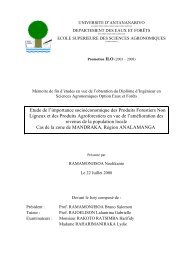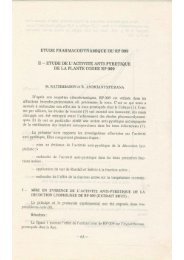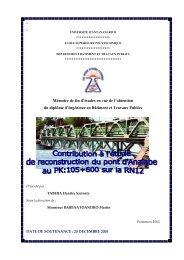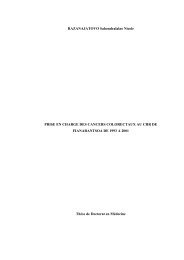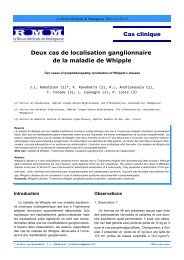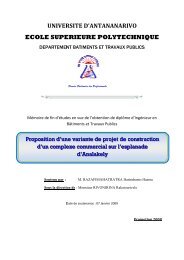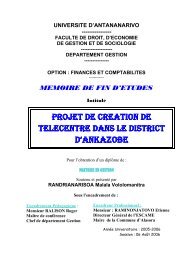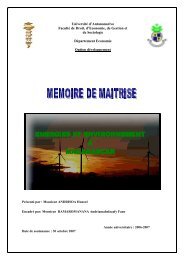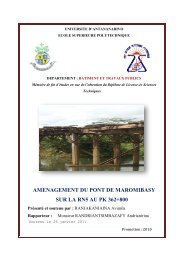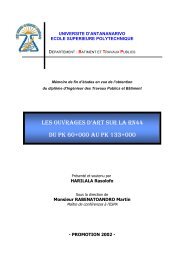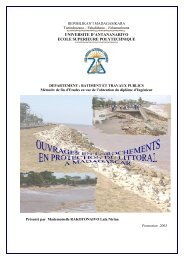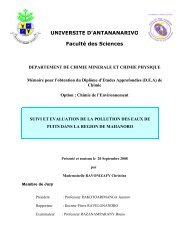universite d'antananarivo faculte de droit, d'economie, de gestion et ...
universite d'antananarivo faculte de droit, d'economie, de gestion et ...
universite d'antananarivo faculte de droit, d'economie, de gestion et ...
You also want an ePaper? Increase the reach of your titles
YUMPU automatically turns print PDFs into web optimized ePapers that Google loves.
TABLE DES MATIERES<br />
REMERCIEMENTS 1<br />
ACRONYMES 2<br />
INTRODUCTION GENERALE 8<br />
PREMIERE PARTIE : I<strong>de</strong>ntification du Proj<strong>et</strong> 14<br />
CHAPITRE I: PRESENTATION DU PROJET. 16<br />
Section 1: Historique. 16<br />
Section 2: Le caractéristique du proj<strong>et</strong>. 17<br />
2.1. Les buts du centre. 17<br />
2.2. Le cadre logique. 17<br />
2.3. Fiche signalétique du proj<strong>et</strong>. 21<br />
2.4. Activités principales du centre. 21<br />
Section 3: Choix <strong>et</strong> présentation <strong>de</strong> la région. 22<br />
3.1. Élément géographique : 22<br />
3.1.1. Localisation du proj<strong>et</strong> dans la région. 22<br />
3.1.2. Carte <strong>de</strong> la région Analamanga. 22<br />
CHAPITRE II: ETUDE DU MARCHE. 23<br />
Section 1: La <strong>de</strong>scription du marché ciblé. 23<br />
1.1. Historique du marché ciblé. 23<br />
1.2. La part <strong>de</strong> marché disponible. 24<br />
1.3. La clientèle cible. 24<br />
Section 2: L’analyse environnementale du marché. 24<br />
2.1. L’étu<strong>de</strong> <strong>de</strong> l’environnement. 24<br />
2.2. Etu<strong>de</strong> <strong>et</strong> typologie du marché 26<br />
2.3. Ciblage <strong>et</strong> segmentation du marché 27<br />
2.4. Capacité d’absorption 27<br />
Section 3: L’analyse <strong>de</strong> la <strong>de</strong>man<strong>de</strong>. 27<br />
3.1. Les caractéristiques <strong>de</strong> la <strong>de</strong>man<strong>de</strong>. 27<br />
3.2. L’estimation <strong>de</strong> la <strong>de</strong>man<strong>de</strong>. 28<br />
Section 4: L’analyse <strong>de</strong> l’offre. 30<br />
4.1. La qualité <strong>de</strong> service à offrir. 30<br />
4.2. La quantité <strong>de</strong> service à offrir. 30<br />
4.3. La qualité <strong>de</strong> produits à offrir. 32<br />
4.4. La quantité <strong>de</strong> produits à offrir. 32<br />
Section 5: Les concurrents. 33<br />
Section 6: Stratégie <strong>et</strong> politique mark<strong>et</strong>ing. 34<br />
6.1. La stratégie adoptée. 34<br />
6.2. La politique. 36<br />
6.2.1. La politique <strong>de</strong>s services : 36<br />
6.2.2. La politique <strong>de</strong>s prix : 37<br />
6.2.3. La politique <strong>de</strong> distribution : 38<br />
6.2.4. La politique <strong>de</strong> communication : 38<br />
6.3. Le mark<strong>et</strong>ing. 39<br />
CHAPITRE III: THEORIE GENERALE SUR LES OUTILS ET LES CRITERES D’EVALUATION. 40<br />
Section 1: Les outils d’évaluation. 40<br />
1.1. La VAN (Valeur Actuelle N<strong>et</strong>te) 40<br />
1.1.1. Définition. 40<br />
1.1.2. Formule. 40<br />
1.1.3. Interprétation. 41<br />
1.2. Le TRI (Taux <strong>de</strong> Rentabilité Interne) 41<br />
1.2.1. Définition. 41<br />
133




